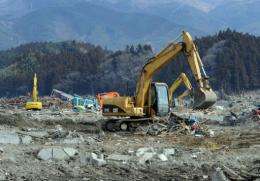Japan disasters could send gadget prices higher

Disaster-hit Japan churns out many of the world's smartphones, video cameras and other gadgets and while sales are not expected to suffer around the globe, industry analysts expect prices to rise.
"From semiconductors to displays, to automotive and consumer electronics, the effects of the Japan earthquake continue to reverberate throughout the world," said Dale Ford, senior vice president at research firm IHS iSuppli.
"Beyond the damage to Japan's own industrial base, the earthquake has impacted the production of basic electronic raw materials," Ford said.
Japan produces between 15 percent and 20 percent of the world's electronics and "plays a particularly key role in some areas," said Jean-Philippe Dauvin of Paris-based consulting company Decision.
Dauvin said 30 percent of the videogames, 40 percent of the video cameras and still cameras and 15 percent of the television sets sold around the world are manufactured in Japan.
He said 40 to 50 of Japan's 140 semiconductor factories have been shut down as a result of the March 11 earthquake and tsunami and noted that DRAM and NAND memory are key components of both tablet computers and smartphones.
Within the next few weeks, there will be disruptions to the global supply chain and higher prices for computer chips, "leading inevitably to higher prices for the consumer," Dauvin said.
"There's about 100 euros ($141) worth of semiconductors in a smartphone," Dauvin said. "There's sure to be memory and Japanese components in there."
Apple's iPad and iPhone, for example, is assembled mostly in China but is brimming with "Made in Japan" parts according to IHS iSuppli, including the battery, electronic compass, NAND and DRAM memory and the touchscreen display.
"The supply chain will begin to dry up within about three weeks," Dauvin said, leading to shortages, delivery delays and forcing the shutdown of some production lines.
Japan's factories usually work at full capacity from April and May to crank out products for later in the year, including the Christmas holidays.
It remains difficult to predict when the country will resume producing at full capacity because aftershocks are continuing to play havoc with factories and electricity remains rationed in some areas.

Gartner research vice president Richard Gordon said he was cautiously optimistic Japan's disasters would not have too much of a negative impact on the global supply chain for electronics.
"Early on, when the earthquake just happened, there was lot of concern that there would be an immediate impact and that it would be quite significant on the global level in terms of a disruption to the electronics supply chain," he said.
"But over the past two or three weeks we've become a bit more optimistic that disruptions will be contained, that there will be enough flexibility in the supply chain to smooth out some of these disruptions," he said.
"It is still possible in the next months, into April and May, that we may see some shortages that we're not forecasting at the moment," Gordon said.
"But at this stage it's a bit early to say so," he said. "We will wait and see how the supply chain copes."
(c) 2011 AFP



















